THE CASE
FOR BILINGUAL
DEAF CHILDREN
By Christine Buckley
Photos by Peter Morenus
Marie Coppola and a number of other researchers at UConn want to understand the science behind how early access to language affects learning in deaf and hearing children. Deaf children are just as intellectually capable as hearing children— but if they do not have early access to language and communication, that intellectual capacity can quickly erode.
THE CASE FOR
BILINGUAL
DEAF CHILDREN
By Christine Buckley
Photos by Peter Morenus
Marie Coppola and a number of other researchers at UConn want to understand the science behind how early access to language affects learning in deaf and hearing children. Deaf children are just as intellectually capable as hearing children— but if they do not have early access to language and communication, that intellectual capacity can quickly erode.
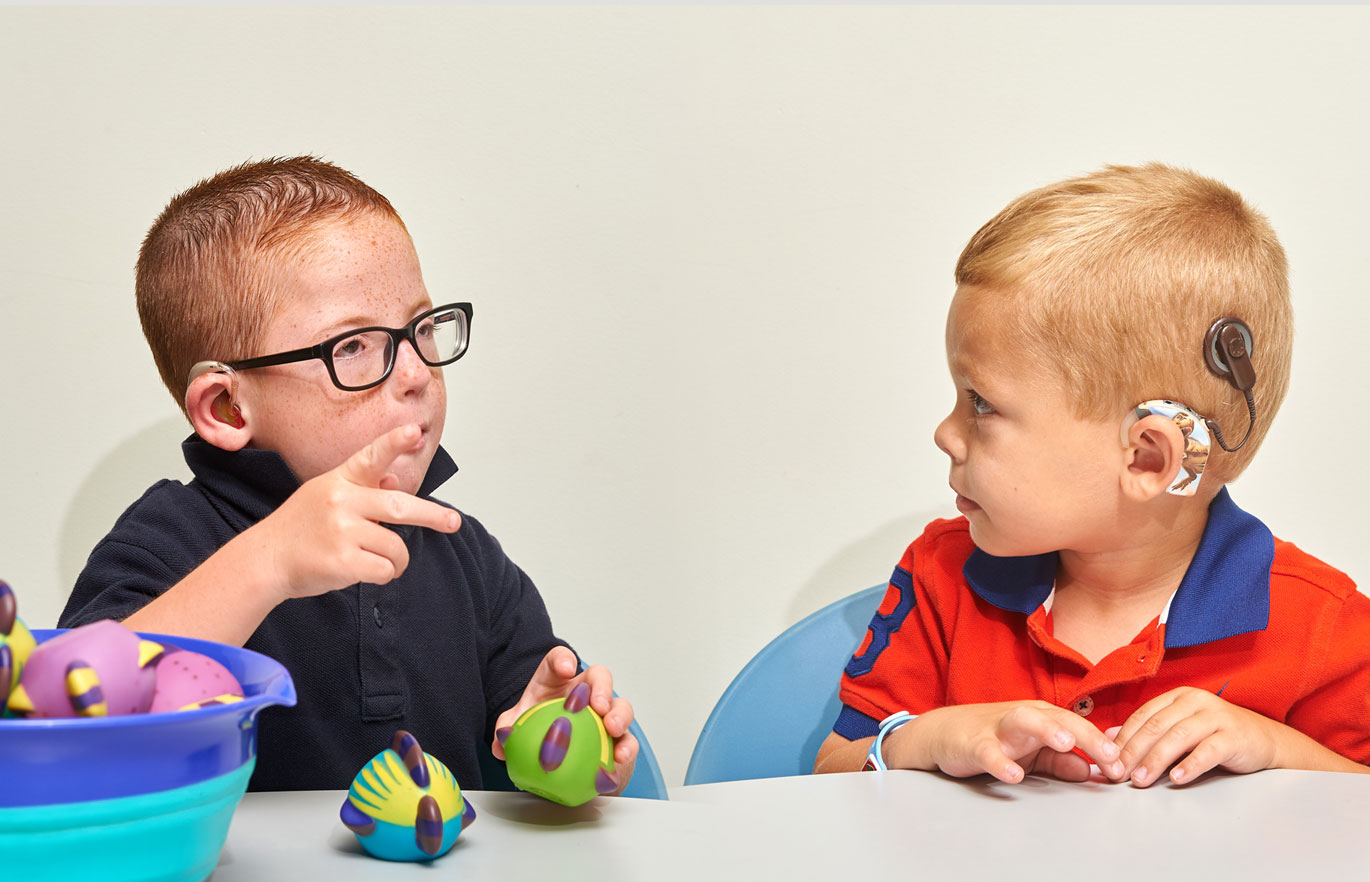
Eight-year-old Marie Coppola could hear the dial tone on the other end of the phone. Second ring . . . third ring. She was a little clammy, but not as nervous as the first few times she'd picked up and dialed on this sunny Philadelphia afternoon.
A middle-aged woman's voice answered. "Hello?"
"Hello," Coppola said, affecting what she thought was a deep, confident tone. "I'm calling about your ad in the Inquirer for cleaning services."
The woman was not fooled. "Excuse me?" she began testily.
"It's for my mother," Coppola rushed on. "She's deaf, but she is highly qualified and can provide references. If you'd like to meet her, I can arrange it. She's available any afternoon this week. . ."
Amy Coppola, standing with a hand on her daughter's shoulder, looked on. Her daughter trailed off, eyebrows furrowed. She tried a few more cajoling words, but finally mumbled, "Okay, thank you," and hung up.
Her mother didn't need to ask. "Better luck next time?" she signed.
"Yes," signed Marie. She trudged across the room, disgruntled.
"I'm going to my room. I'll be back for dinner," she signed — in the Deaf custom of telling people where you're going when you leave, and when you'll be back — before disappearing down the hall.
Forty years later, Marie Coppola, now assistant professor of psychological sciences and linguistics in the College of Liberal Arts and Sciences, is still disgruntled. Even today, amid a surge of technology that promises to give deaf and hard-of-hearing people access to sound, Coppola says Deaf people, along with their language and their culture, are not being heard.
Coppola was recently awarded a $1.2 million National Science Foundation (NSF) CAREER Award, one of the largest in the program's history, to study the impact of early language experiences — whether spoken or signed — on how children learn. She hopes her work will help people better understand that sign language is just as worthy as spoken language.
A CHILD OF DEAF ADULTS
Like the hundreds of thousands of Deaf people in the U.S. who use American Sign Language (ASL), Marie's parents, Amy and Richard Coppola, refer to themselves as Deaf, with a capital D. Amy was deaf from birth, while Richard lost his hearing as a baby after delivery complications and contracting scarlet fever. Although Richard attended a residential school that taught him sign language, his family never learned to sign.
Amy went to an oralist school in Philadelphia, which emphasized lip reading and producing speech and didn't teach sign language. The oralist tradition is based on the 1880 International Congress on Education of the Deaf, which declared speech communication superior to manual communication and banned the use of sign languages in deaf schools. Not until 1980 did the same Congress repudiate this resolution, saying that "all deaf children have the right to a flexible communication."
"People were told that if they learned to sign, it would be harmful to their development," says Marie. "People are still getting that message today."
Richard attended Gallaudet University, the only comprehensive university for the Deaf in the world, and studied library science. But in the 1970s, before the Americans with Disabilities Act, he was unable to find library work. He worked nights at the Philadelphia Post Office, sorting business reply mail. Amy found odd jobs, like cleaning houses, when she could.
Yet the Coppolas lived happily within the robust Philadelphia Deaf community. They attended Deaf sporting, poetry, and storytelling events. Amy traveled to conferences as a delegate for the International Catholic Deaf Association. Richard, a lover of adventure, dragged a reluctant 16-year-old Marie and her two younger brothers on a 42-day road trip to Los Angeles for the Deaflympics in 1985 — complete with a stop in every state, including Texas to visit Southfork Ranch, where "Dallas," one of the first shows to be closed-captioned, was filmed.
"We loved the Deaf Olympics," remembers Coppola. "But 13,768 miles in a car with your dad would make any teenage girl go a little crazy."
Sign languages — there are around 130 worldwide — are fully developed languages, with their own lexicon and structure. But from an early age, Coppola detected subtle signs that people saw ASL, which has an estimated 500,000 speakers, as a sign of stupidity.
"People would say really insulting things about my mother, like at the grocery store," she remembers. "Of course, she knew people said horrible things. But I wanted to shield her. As a child, that's a hard position to be in."
As an undergraduate at MIT, Coppola used her ASL fluency to study language structure with renowned psychologist Steven Pinker. In graduate school, she traveled yearly to Nicaragua to study how Nicaraguan Sign Language, which materialized spontaneously in the late 1970s, had developed and evolved.
When Coppola arrived at UConn in 2010, she brought with her more than a decade of research experience studying how sign languages are created. Now she turned her attention to what she considers a more pressing public concern: how deaf children learn.
"It just makes sense: around the world, children grow up bilingual and trilingual, and have no cognitive issues...So why should sign language and spoken language be different?"
FORBIDDEN SIGNS
In the early 1980s, when Coppola was still in high school, cochlear implants (CIs) were approved for use in children ages two and older. The technology, a system of electrodes surgically implanted into the inner ear to artificially stimulate hearing cells, has become a go-to medical solution for children born deaf. The implants have been applied to an estimated 350,000 people worldwide, and can be implanted at one year old, in some cases younger. They're considered so successful that access to some sound is an option for the majority of deaf people.
Since 95 percent of deaf people are born to hearing parents, the majority of families with deaf children would like their children to hear, says Board of Trustees Distinguished Professor of Linguistics Diane Lillo-Martin, who has been studying sign language for 30 years. As a result, fewer and fewer deaf children are learning sign language, she says. And in some cases, this leaves children with no access to language at all, since CIs have varying degrees of success. "It's not like glasses, where you put them on and you can see perfectly," says Lillo-Martin. "Electronic hearing is very different from acoustic hearing."
Harking back to the oralist tradition, audiologists and doctors who treat deaf children receiving CIs regularly tell parents that their child must not use sign language, because it will interfere with their ability to learn to speak. Further, parents are told that a lack of auditory input at a young age will prevent the brain from developing normally. These claims were backed up by research studies, most conducted by the implant's inventor, Graeme Clark.
But more recent research, including work by Lillo-Martin, shows the opposite: that learning ASL does not impair speech development. In July 2015, a panel of doctors and psychologists weighed in on the CI issue in the medical journal Pediatrics, and concluded: "The benefits of learning sign language clearly outweigh the risks. For parents and families who are willing and able, this approach seems clearly preferable to an approach that focuses solely on oral communication."
"It just makes sense: around the world, children grow up bilingual and trilingual, and have no cognitive issues," says Lillo-Martin. "So why should sign language and spoken language be different?"
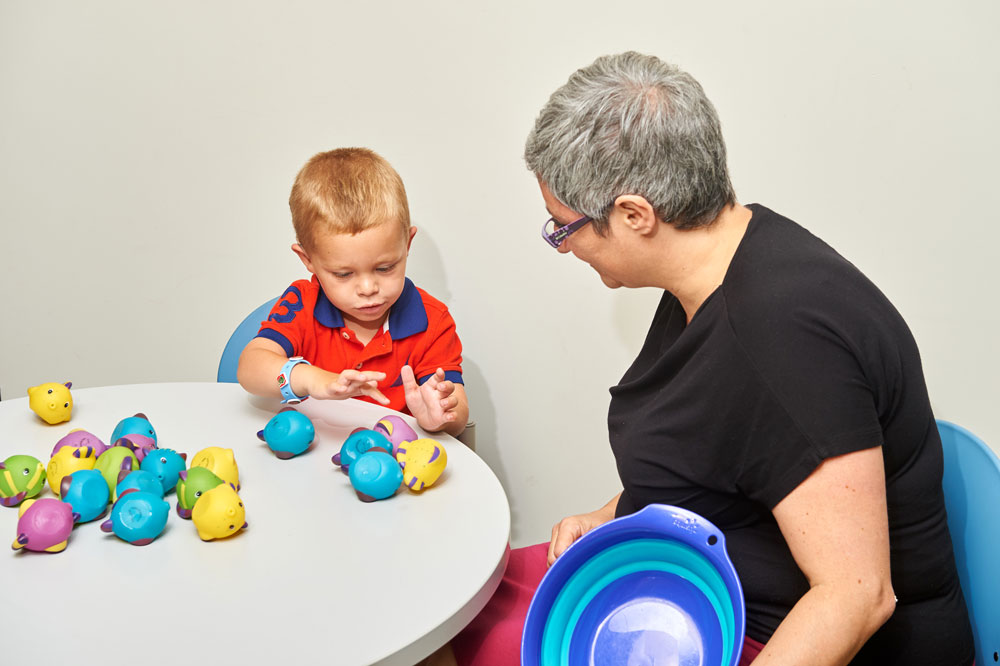
Assistant Professor of Psychological Sciences and Linguistics Marie Coppola asks children to count fish during the testing phase of a national study she will oversee this year. Funded by a $1.2 million National Science Foundation CAREER Award, the first phase of the study will compare the math skills of hearing children who get spoken English from birth with those of deaf children of signing parents who get American Sign Language from birth.
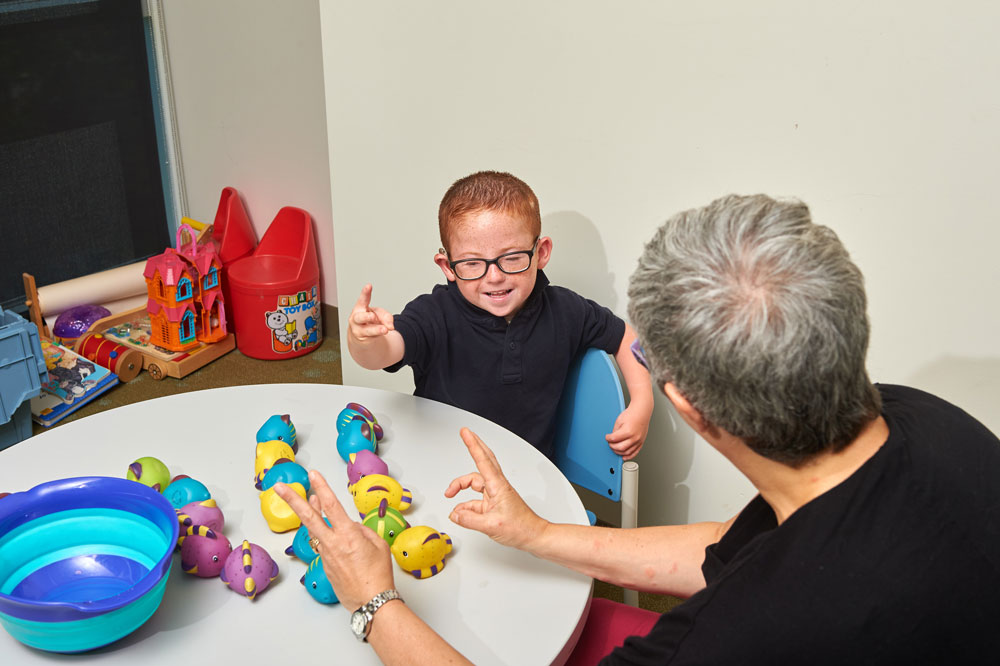
MADE TO HEAR
That hearing parents of deaf children are still counseled not to teach their children sign language continues to baffle Laura Mauldin, assistant professor of human development and family studies.
"I'm an intensely social person," says Mauldin, explaining how she learned ASL from a handful of mainstreamed Deaf students at her public school outside Houston, Tex. "I followed the Deaf students around, and they were very patient with me," she says with a laugh. "It ended up shaping the trajectory of my life."
Mauldin attended Gallaudet as one of the first hearing people accepted to its ASL master's program, and did her Ph.D. at the CUNY Graduate Center in New York. Having watched the cochlear implant controversy unfold from the perspective of the Deaf community, she wanted to learn about the other side: the hearing families into which deaf children are born. As a medical sociologist, she studies the effects of medicine on contemporary life.
"I'm interested in care, and the pressures on parents, particularly mothers, to provide good care to their children," she says.
For six months, Mauldin observed clinicians working with the parents of deaf children who were candidates for CIs, from birth to age six, at an audiology clinic in the New York City area. The result was her February 2016 book Made to Hear, which documents the long CI process. After months of screenings and approvals, a child has the surgery; weeks or months of adjustments follow, then years of auditory training to understand speech.
"You see those videos on YouTube of people having their implant turned on and hearing for the first time, and it's supposedly this beautiful thing," she says. "But the implant is not the treatment. The treatment is that it's the parents' job to retrain that child's brain, over years of work, to understand what's being sent to it."
Mauldin observed that most successful CI children were from white middle-to-upper-class families, often with a mother or father who could afford to stay home and devote themselves to their child's training. Further, the advice against sign language was couched in neuroscience: parents were told that if the children learned to sign, neural pathways for visual language would develop, and spoken language pathways wouldn't. Mauldin found this ironic.
"The message was: the brain is plastic enough that we can make your child hear and speak, if you put in the work on those synapses and create those pathways for spoken language," she says. "But it's not plastic enough to be able to learn both sign and speech at the same time, so definitely don't do that."
In the end, Mauldin felt herself sympathizing with the families she watched struggle to get the right information and make decisions surrounding the disability. She hopes that the Deaf community will read her book, and gain some sympathy toward the hearing parents of deaf children.
"It's not like glasses, where you put them on and you can see perfectly. Electronic hearing is very different from acoustic hearing."
BILINGUAL AND BICULTURAL
In May, Nyle DiMarco, the recent winner of "America's Next Top Model," won "Dancing with the Stars." The Deaf math-major-turned-model-turned-dancer hails from a multigenerational Deaf family, and used his fame to bring issues of Deaf education to a national audience. His eponymous foundation advocates for bilingual education, meaning that Deaf children should learn both a signed language and a spoken language from birth.
The Deaf community is now working to convince people that bilingualism will not only cause no harm to their child, but will allow children to be bicultural — to be part of a community that can enrich their lives. It's a tough sell to families, but Coppola thinks it's a simple matter of access.
"Right now there's no political will to get these kids access to ASL, because people believe that cochlear implants simply make you hearing," says Coppola. "You can't get a cochlear implant the instant you're born, so right off the bat, there's a difference in exposure to language." Coppola's NSF award will support her research on cognitive development in deaf children. A new Deaf graduate student, Jessica Contreras, arrived on campus this month to work on the project.
The project will explore the idea that deaf children struggle to learn not because they're deaf, but because most of them, coming from hearing families who didn't teach them ASL, were deprived of early language input.
The first experiment will compare the ability to understand numbers in hearing children who get spoken English from birth, with that of deaf children of signing parents who get ASL from birth. She expects to see no differences between these groups.
Then, Coppola will compare deaf children who receive sign language from birth with those who receive sign or spoken language input later in life. She expects that later language access will emerge as the reason for cognitive delay. If it does, her study would be the first to show quantitatively that the ability to understand numbers is not driven by access to sound, but by access to language — whether it's spoken or signed.
"Everybody expects some degree of language deprivation, and some degree of cognitive delay," she says of deaf children. "I strongly resist that. It doesn't have to be that way."
But the resources available to help families who want to teach their deaf child to sign are pitifully low, says Coppola. As one parent in Mauldin's clinic put it: "Do you think I had my child and a sign language dictionary came out of my butt?"
In Connecticut, the state government, through the American School for the Deaf, offers about one hour of training per week for eight to twelve weeks, for families of deaf children under three.
In other states, support is much lower.
Foundations like DiMarco's advocate that federal resources should fund ASL programs. For some deaf children, CI technology works only partially or not at all — and if those children haven't learned to sign, they end up with no quality language access. That's the worst tragedy, says Coppola.
But technology is also advancing for ASL access. Apps like Convo allow Deaf people to access interpreters from anywhere in the world through their smartphones, so they can make phone calls. Prototypes of wearable devices that translate ASL into English are being developed. And even old-fashioned email improves Deaf people's access to business and commerce.
Interest in ASL, which by some estimates is the third most frequently used language in the United States, has increased, with many high schools — eight across Connecticut at last count — offering ASL as a foreign language. UConn, too, offers ASL courses.
When Coppola visits her parents now, she senses they're proud of her and her research. But they don't talk about it directly. Instead, they mostly talk about Coppola's two children, who speak English and Dutch natively, and are learning ASL. For them, Coppola notes, bilingualism hasn't hindered development.
"Access to two languages is just better than access to one," she says. "I am all for something that increases kids' capacities, as long as they get language early. Getting language early is the most important thing."
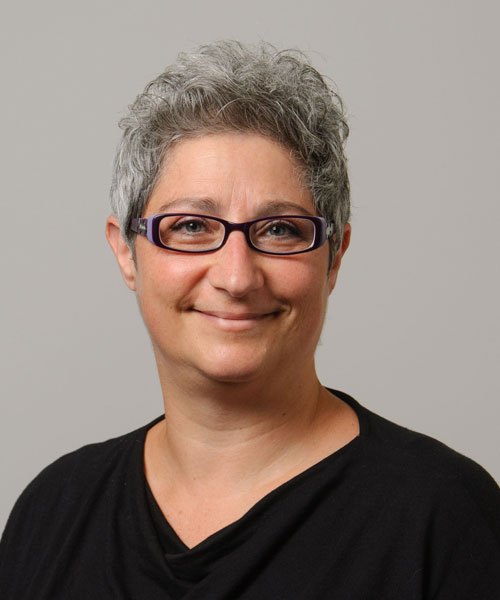
Marie Coppola
Assistant professor of psychological sciences and of linguistics and director of UConn's Language Creation Lab, Coppola this year received the prestigious National Science Foundation CAREER Award. The $1.2 million award will provide five years of support for research on the impact of language experience on number development in deaf and hearing children, focusing on how early exposure to language fosters typical development in numerical cognition.
Photo by Peter Morenus
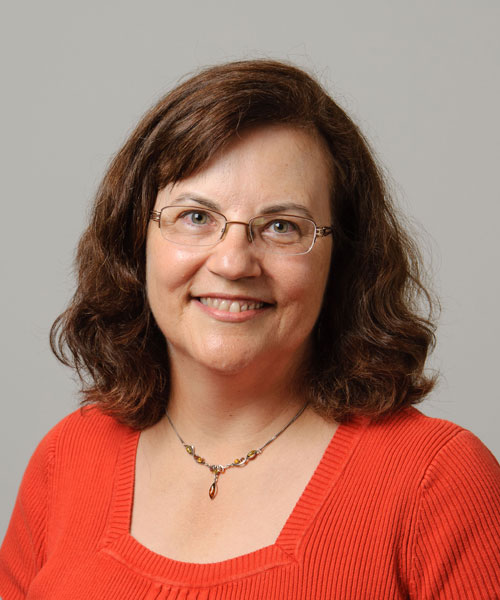
Diane Lillo-Martin
Board of Trustees Distinguished Professor of Linguistics, Lillo-Martin also is coordinator of American Sign Language studies at UConn. The primary project of her fellowship involves the development of a digital archive through which video recordings of children using ASL in interactions with their Deaf parents and other signers and other legacy data will be shared with the signing and research communities.
Photo by Peter Morenus
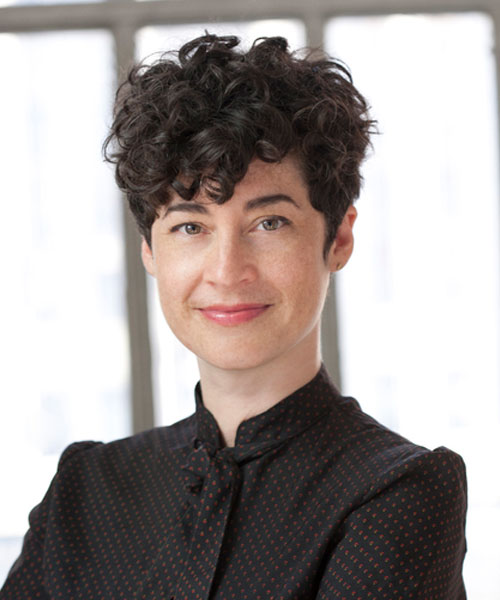
Laura Mauldin
Assistant professor of human development and family studies and of women's, gender, and sexuality studies, her book Made To Hear is based on an ethnography of a cochlear implant (CI) clinic and examines the use of CIs in deaf children, the role of neuroscience in the culture of intervention around deafness, and how parents are expected to adopt CIs for their deaf child.
Photo by Michael Ian

I am a mother of 2 Deaf children and we were told not to sign with either of our children. We received very little to no educational support in NJ and recently have moved to MA in a stronger Deaf community. I’m glad this research will be there it seems like it is so hard to find studies in this because it is so new.
Thank You for this information. As a father of a deaf child who received his CI when he was four years old, (1997), we were told to not use sign language. His mother & I felt it was good for him to learn ASL, as the equipment some times failed him. I feel he has benefited more from learning both. He spent many days in speech therapy also over the years. One of his issues seemed to be his brain would think faster than he could speak so the words came out mixed up. He could repeat single words very well. One of the areas he struggles with would be the two languages differ in syntax. Thank You for your work in this area, as there is great value in learning how the human brain really works vs. what we thought worked. Sincerely yours, Alan Main
Fantastic article. Time to get the bilingual message out there! One correction – in Australia we routinely implant between 6 and 12 months.
my daughter is 12 years old and is hard of hearing, who has excellent speech. We chose to teach her sign as soon as we found out she was hard of hearing at 2 weeks old. She is aided, and mainstreamed in general Ed classes with an interpreter. Without the ASL she would not be where she is today. Many told us that she was on the fence. Not deaf, but not hearing. We have always believed that she is a bridge between the deaf and hearing worlds. She can go between both and help others go back and forth as well.
I have a 3 year old deaf son. He was diagnosis with auditory neuropathy one month before his second birthday. He had no language for 2 years. He has a CI on the left side and attends the local deaf school Monday through Friday. I was told not to sign with him and push spoken English. I have been learning ASL, 3rd language, for almost 2 years now. I get told many times I’m wrong, I’m hindering his ability to learn spoken English. I know there is chance with the auditory neuropathy that he may never fully develop spoken English. I don’t worry about that. I want to give him a language he can use and depend on. He’s deaf and will always be deaf. The ci may help him hear, he may develop spoken English. I am proud how well and fast he’s picking ASL. My older 2 kids are hearing and are also learning ASL as their 3rd language as well. I fully believe no language hindering cognitive development more than sign language. I see it first hand with my son. I implanted him so he can have a choice as an adult if he wants the ci and wants to use. The auditory nerve has a chance of dying or so I was told. I thought it would be in his best interest to implant and keep activating the nerve so if he wants to develop spoken language he has that option. I only pray that he can see that when he’s older and doesn’t think that I tried to \fix him\”. I proud to be a part of the deaf culture through him and watching him grow in this amazing culture. Thank you for reading the post.”
“My oldest child is deaf and received a cochlear implant at the age of 5. We have used sign language with him and our hearing children. They all have great language skills.
He was without his cochlear implant for a month and when he got it back on he exhibited the classic reaction of tearing up. As the programming session went on he expressed that it was too loud and driving him nuts. I think the tearing up reflex is indicative of stimulated nerves triggering tears, rather than an emotional outpouring. I am grateful for the cochlear implant, and I dislike the way activation is often portrayed as though the recipient can suddenly hear/understand/hallelujah!”
As I read this, it brings tears to my eyes. It brings back memories of my early childhood that Marie discusses in this article about making phone calls for our deaf parents and the struggles we went through and still go through. I am so proud of my sister Marie Coppola for the work and research she is doing in this area. She is a true advocate for the deaf community. Keep up the great work sis!! Love you! Xoxo
Can someone explain the logic behind convincing parents with hearing children to teach their kids baby sign language so they could ostensibly communicate earlier at the same time we were telling people with deaf babies NOT to let them learn ASL?
Those of us in Deaf education have been asking that for years.
“I don’t have any children that are deaf, but my son didn’t talk until he was 3 or 4 years old.
His speech therapist said to teach him
sign language so he wouldn’t be frustrated. If it wasn’t
for that, maybe he wouldn’t have communicated until later. In the meantime, I went to classes for ASL
so I could communicate with him. My son doesn’t sign anymore, but once in awhile I meet someone
who is deaf and I try to sign.They seem to accept my signing- maybe my signing isn’t perfect, but non hearing people are the sweetest as they tell me I’m signing very well, but I know I’m not.
I think there should be more research about CI’s and anything that can help people who are deaf. UCONN is a wonderful school and I hope this five year study goes well!”
My son is 3 and one of our audiologists in the UK asked my why I signed to him because he should do well with his hearing aids, I kindly reminded him that my son is deaf, and there is no way that I will create a barrier of communication. It has been so useful and removes the frustration for him and us as his parents. Alas, hearing aids didn’t help him enough and he has bilateral cochlear implants (switched on last week), My son has done very well with BSL, he thrives on it and will continue to do so. His deaf heritage will not be eroded by implants. Total communication is the way forward. It’s a no brainier!! Good luck to you all and thanks for sharing this article
I use my eyes, face muscles (frowning, smiling) and hands to communicate with people from different countries. When I watch silent movies I do not need words to understand the story told. I believe that deaf people are beter in non verbal communication! Every child should be able to learn a language, spoken and/or ASL.
Thank you for your diligence in conducting this study on exposing the reality of CI’s, and making the case for bi-lingual deaf children. I am the grandmother to the little boy pictured and the mother of his father. For 35 years I have advocated for bi-lingual deaf children. I have expressed my concens about the CI because of unrealistic claims. 35 years ago I had the pleasure of meeting Dr. Ruben of Einstein Hospital, in the Bronx. He diagnosed my son as profoundly deaf, due to Waardenburg Syndrome. Being a hearing mother Dr. Ruben warned me I may be getting calls from Doctors in California to have my son be considered for a cochlea implant, and explained they are preying on hearing parents because they want their child to hear. He advised me there were only 13 channels on the CI, whereas on the cochlea nerve their are thousands of hairs which enable us to hear. To simplify matters, he further told me the CI with its 13 channels is equivelent to the Wight brothers wanting to build a plane and your son needs a 747. Thirty five years later the CI only has 26 channels to replace the thousands of hairs on the cochlea nerve. Dr. Ruben told me to go home and find a school for the deaf which supported total communication. He further told me that language development accurs with the first 18 months. My son was a little under 1 year at the time. I found Cleary School for the Deaf, which was the beginning of my son reaching his full potential. I am grateful to the people in the past that helped me to help my son achieve his potential. I have been almost chastized in the past because of my views on the cochlea implant, I consider my son as testimony to your study that deaf children should be bi-lingual and be taught sign language as early as possible before 18 months. If you feel I can assist you with any input or advocacy regarding this study, It would be an honor to me.
A very interesting and persuasive article. Marie, I am proud of you.
Love and kisses from Holland.
Hello, I agree with your study and I’m glad you are doing this. I’m a mother of a deaf child and we are hearing parents. My child’s first language is ASL and we are continue to learn ASL. She is currently 20 months old and started learning sign language since she was born. She recently received bilateral CI (2016) it’s been about 3 full month since her activation and she’s already saying about 50 spoken words and signing those words at the same time. I have spend hours with her learning signs language she know 100+ Signs. But I completely believe that she’s doing so well with her CI because she knows the words in sign language and it was easier to connect that spoken word with the sign word. I hope that many people benefit with this study that is crucial bilingualism. ASL is a must for a deaf child they are born to be visual learners and that will only help them if the parents choose CI.